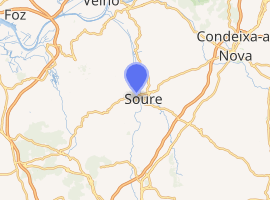Soure train crash
The Soure train crash occurred on 31 July 2020 when a high-speed passenger train collided with a track maintenance vehicle at Soure, Portugal. Two people were killed and 43 were injured, three seriously.
| Soure train crash | |
|---|---|
.jpg) Unit 4005, the train involved in the accident | |

| |
| Details | |
| Date | 31 July 2020 15:26 |
| Location | Soure |
| Coordinates | 40°03′28″N 8°38′18″W |
| Country | Portugal |
| Line | Linha do Norte |
| Operator | Comboios de Portugal / Infraestruturas de Portugal |
| Service | Lisbon - Braga |
| Incident type | Collision |
| Cause | Human error (SPAD)[1] |
| Statistics | |
| Trains | 2 |
| Passengers | 212 |
| Crew | 2 (VCC) + 2 (passenger train) |
| Deaths | 2 (in the VCC) |
| Injured | 43 |
Accident
At 15:26 on 31 July 2020, Alfa Pendular high-speed passenger train No. 4005 carrying 212 passengers collided with rail maintenance vehicle (Portuguese: Veículo de Conservação de Catenária - VCC) No. 105 at Soure and was derailed.[2] The passenger train was travelling at 190 kilometres per hour (120 mph) at the time of the collision.[3] Two people were killed and 43 were injured, three seriously.[2] Two rescue helicopters and 163 rescue personnel were sent to the scene,[3] where a field hospital was established.[4] The train was travelling from Lisbon to Braga, calling at Coimbra and Oporto.[3] The Alfa Pendular train was severely damaged. VCC No. 105 was destroyed.[4]
Investigation and Aftermath
.jpg)
The Gabinete de Prevenção e Investição de Acidentes com Aeronaves e de Acidentes Ferriviários (GPIAAF) opened an investigation into the accident. Early indications are that the maintenance vehicle passed a signal at danger and was run into by the passenger train.[2]
In the wake of this accident, the absence of automatic train protection (ATP) in maintenance vehicles was scrutinized[5]. It came to light that, in 2018, after several events where such vehicles passed signals at danger, GPIAAF recommended that IP reassess the possibility of equipping these vehicles with ATP and act to ensure train driving qualifications of their maintenance staff[6]. IP agreed to install ATP, but this was met with difficulties in sourcing CONVEL-compatible equipment from Bombardier[6][7].
While the suspected cause would be human error — the driver passing the signal at danger —, ATP would have prevented this accident by braking the maintenance vehicle[1]. Its incursion into the reserved block was, however, detected by the track circuit and signals were updated accordingly, but the passenger train had already passed the previous signal and balise, and proceeded at top speed expecting a clear track ahead[2].
References
- "Erro humano causou acidente com Alfa Pendular em Soure. Operadores da máquina passaram o sinal vermelho" [Human error caused an accident with Alfa Pendular in Soure. Machine operators passed the red light] (in Portuguese). Público. 1 August 2020. Retrieved 9 August 2020.
- "NOTA INFORMATIVA DE ACIDENTE" [Notice informing of accident] (in Portuguese). Gabinete de Prevenção e Investigação de Acidentes com Aeronaves e de Acidentes Ferroviários - GPIAAF. 31 July 2020. Retrieved 1 August 2020.
- "Coimbra train crash: Two dead after train derails in Portugal". BBC News Online. 31 July 2020. Retrieved 1 August 2020.
- Speare-Cole, Rebecca (31 July 2020). "Portugal train crash: Two dead and at least 37 injured as high-speed train collides with maintenance vehicle". The Evening Standard. Retrieved 1 August 2020.
- "Dois mortos em acidente com alfa pendular na zona de Soure" [Two killed in accident with alpha commuting in the Soure area]. SIC Notícias. 31 July 2020. Retrieved 10 August 2020.
- Lusa. "IP comprometeu-se há dois anos instalar sistema CONVEL em Veículos de Conservação de Catenária" [IP committed two years ago to install CONVEL system in Catenary Conservation Vehicles] (in Portuguese). RTP. Retrieved 10 August 2020.
- Carlos Cipriano (8 August 2020). "IP diz que monopólio europeu travou solução que evitava acidente de Soure" [IP says European monopoly caught solution that prevented Soure accident] (in Portuguese). Público. Retrieved 10 August 2020. (Subscription required.)